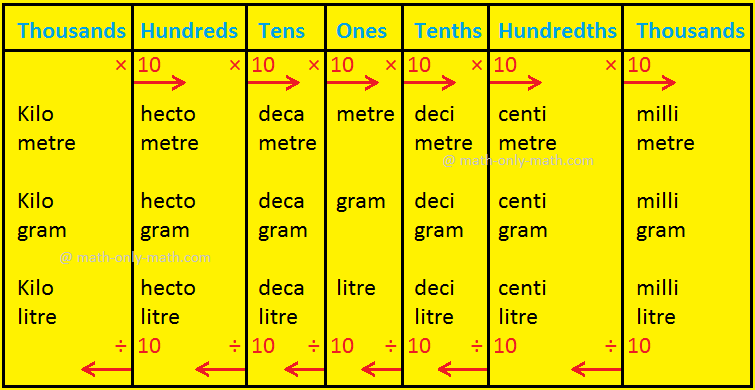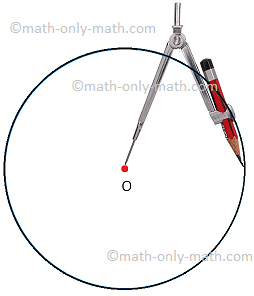Metric Measures
We will discuss here about the metric measures of length, mass and capacity.
Measurements of length, mass and capacity:
We know about the different units for measuring length, mass and capacity. We also know about the relationship between the units.
Let us revise them.
Length is measured in kilometre, metre and centimetre.
Mass is measured in kilogram and gram.
Capacity is measured in litre and millilitre.
You know that
1 metre = 100 centimetres
1 kilometre = 1000 metres
1 kilogram = 1000 grams
1 litre = 1000 millilitres
The basic unit of length is metre, the basic unit of mass is kilogram and the basic unit of capacity is litre. This system of measurement of length, mass and capacity is known as Metric system.
In metric system, we represent thousands by kilo, hundreds by hector, tens by deca, tenths by deci, hundredths by centi and thousandths by milli. This system is decimal since each unit is 10 times the next smaller unit.
As we know, the standard units of length, weight and capacity are metre (m), gram (g) and litre (l) respectively. Kilometre (km) kilogram (kg) and kilolitre (kl) are the bigger units of length, weight and capacity respectively. The three-basic unit systems of measurement of length, mass and capacity is known as metric system.
This is decimal system based on the multiples of 10.
Measures of Length
|
10 millimetres (mm) 10 centimetres 10 decimetres 10 metres 10 decametres 10 hectometres |
= = = = = = |
1 centimetre (cm) 1 decimetre (dm) 1 metre (m) 1 decametre (dam) 1 hectometre (hm) 1 kilometre (km) |
Measures of Weight
|
10 milligrams (mg) 10 centigrams 10 decigrams 10 grams 10 decagrams 10 hectograms |
= = = = = = |
1 centigram (cg) 1 decigram (dg) 1 gram (g) 1 decagram (dag) 1 hectogram (hg) 1 kilogram (kg) |
Note:
100 kg = 1 quintal
10 quintals = 1 tonne
1000 kg = 1 tonne
Measures of Capacity
|
10 millilitres (ml) 10 centilitres 10 decilitres 10 litres 10 decalitres 10 hectolitres |
= = = = = = |
1 centilitre (cl) 1 decilitre (dl) 1 litre (l) 1 decalitre (dal) 1 hectolitre (hl) 1 kilolitre (kl) |
We can understand the metric system more clearly through the following table of metric measures.
|
Thousand 1000 |
Hundred 100 |
Ten 10 |
One 1 |
Tenth 1/10 |
Hundredth 1/100 |
Thousandth 1/1000 | |
|
Metric Unit |
Kilo (x1000) |
Hecto (x100) |
Deca (x10) |
Basic Unit |
Deci (÷ 10) |
Centi (÷ 100) |
Milli (÷ 100) |
|
Mass |
Kilo- gram |
Hecto- gram |
Deca- gram |
Gram |
Deci- gram |
Centi- gram |
Milli- gram |
|
Length |
Kilo- metre |
Hecto- metre |
Deca- metre |
Metre |
Deci- metre |
Centi- metre |
Milli- metre |
|
Capacity |
Kilo- litre |
Hecto- litre |
Deca- litre |
Litre |
Deci- litre |
Centi- litre |
Milli- litre |
Measurement of length, mass and capacity tables can be represented in the form of a place-value chart as shown below.
From the above table of metric system we come to know that:
Deca means 10 times
Hecto means 100 times
Kilo means 1000 times
These are the bigger units of metric system
Deci means \(\frac{1}{10}\) times
Centi means \(\frac{1}{100}\) times
Millimeans \(\frac{1}{1000}\) times
These are the smaller units of metric system
Questions and Answers on Metric Measures:
I. Convert 1629 grams into
(i) kilograms
(ii) hectograms
(iii) decagrams
Answer:
I. (i) 1.629 kilograms
(ii) 16.29 hectograms
(iii) 162.9 decagrams
II. Convert 4525 millilitres into
(i) litres
(ii) decilitres
(iii) centilitres
Answer:
II. (i) 4.525 litres
(ii) 45.25 decilitres
(iii) 452.5 centilitres
III. Convert 4020 metres into
(i) kilometres
(ii) hectometres
(iii) decametres
Answer:
III. (i) 4.02 kilometres
(ii) 40.2 hectometres
(iii) 402 decametres
IV. Convert 1756 kilograms into
(i) quintals
(ii) tonnes
Answer:
IV. Convert 1756 kilograms into
(i) quintals
(ii) tonnes
V. Convert 726 quintals into tonnes
VI. Convert 125 kilometres into
(i) hectometres
(ii) decametres
(iii) metres
VII. Convert 75 kilograms into
(i) decigrams
(ii) centigrams
(iii) milligrams
VIII. Convert 120 litres into
(i) kilolitres
(ii) decalitres
(iii) decilitres
(iv) millilitres
IX. Convert 7 tonnes into
(i) kilograms
(ii) quintals
X. Convert 825 quintals into kilograms.
XI. Fill in the blanks:
(i) 5 kg 600 g = 4 kg ……… g
(ii) 3 hm 20 m = ……… m
(iii) 6 hl 4 dal = ……… l
(iv) 5 m 6 dm = ……… cm
(v) 1 km 2 hm 3 dam 2 m = ……… m
From Metric Measures to HOME PAGE
Didn't find what you were looking for? Or want to know more information about Math Only Math. Use this Google Search to find what you need.
Recent Articles
-
Dividing 3-Digit by 1-Digit Number | Long Division |Worksheet Answer
Apr 24, 24 03:46 PM
Dividing 3-Digit by 1-Digit Numbers are discussed here step-by-step. How to divide 3-digit numbers by single-digit numbers? Let us follow the examples to learn to divide 3-digit number by one-digit nu… -
Symmetrical Shapes | One, Two, Three, Four & Many-line Symmetry
Apr 24, 24 03:45 PM
Symmetrical shapes are discussed here in this topic. Any object or shape which can be cut in two equal halves in such a way that both the parts are exactly the same is called symmetrical. The line whi… -
Mental Math on Geometrical Shapes | Geometry Worksheets| Answer
Apr 24, 24 03:35 PM
In mental math on geometrical shapes we will solve different type of problems on simple closed curves, polygons, basic geometrical concepts, perpendicular lines, parallel lines, circle, terms relates… -
Circle Math | Terms Related to the Circle | Symbol of Circle O | Math
Apr 24, 24 02:57 PM
In circle math the terms related to the circle are discussed here. A circle is such a closed curve whose every point is equidistant from a fixed point called its centre. The symbol of circle is O. We… -
Fundamental Geometrical Concepts | Point | Line | Properties of Lines
Apr 24, 24 12:38 PM
The fundamental geometrical concepts depend on three basic concepts — point, line and plane. The terms cannot be precisely defined. However, the meanings of these terms are explained through examples.





